Mandible A (Pl. 2. 4)
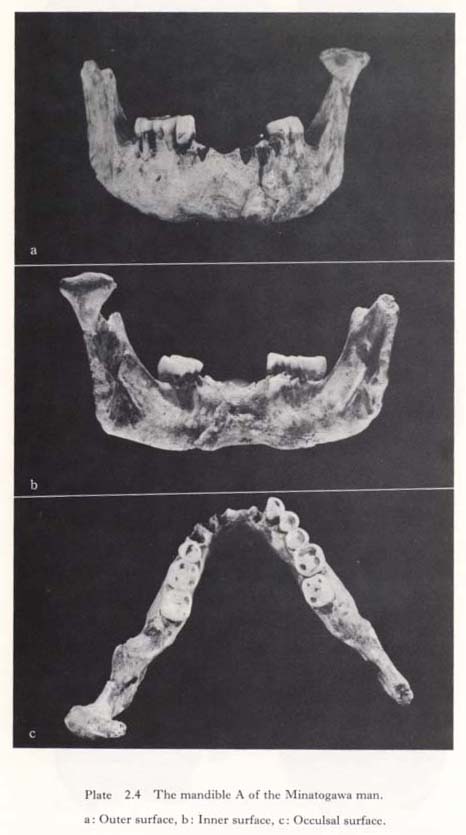
This mandible was excavated from the border between areas C6 and D6 below Minatogawa I. It is almost complete and in a good state of preservation. Its size is very small; the third molar is not yet erupted and the second molar is slightly worn. The mandible is thus considered to belong to a young adult female individual.
In the lateral aspect, there is no praeangular notch on the basal part of the body of the mandible. The basal margin between the two anterior marginal tuberosities is bent upward, forming a submental notch. The mental foramen is of moderate size and is located below Pm1-Pm2. The chin eminence is moderately developed. Both the median incisors are extracted. The tooth sockets of these teeth are completely obliterated, and their alveolar margin indicates a concave sharp ridge 10 mm long.
In the medial aspect, the alveolar prominence rises strongly medialward, and below this prominence the basal part recedes laterally to form a wider and deeper depression than that in modern man. No mandibular tori can be seen.
The groove for the sublingual gland is markedly developed. There is a slight indication of superior and inferior transverse tori as well as fossula supraspinata.
The ramus is 58 mm high and 28 mm wide, and its index (48.3) indicates a much higher mandible than that of the modern female Japanese (54.1).
Between the torus triangularis and the oblique line of the ramus, very wide and deep paraecoronoid fossa can be seen as in the Minatogawa I skull. The outer and inner surfaces of the gonial area of the ramus are markedly depressed and covered with clearly evident muscle relief impressions. From these mandible features, it is supposed that the chewing muscles attached to the mandible are markedly developed for a female individual.
Mandible B (Pl. 2. 5, 2)
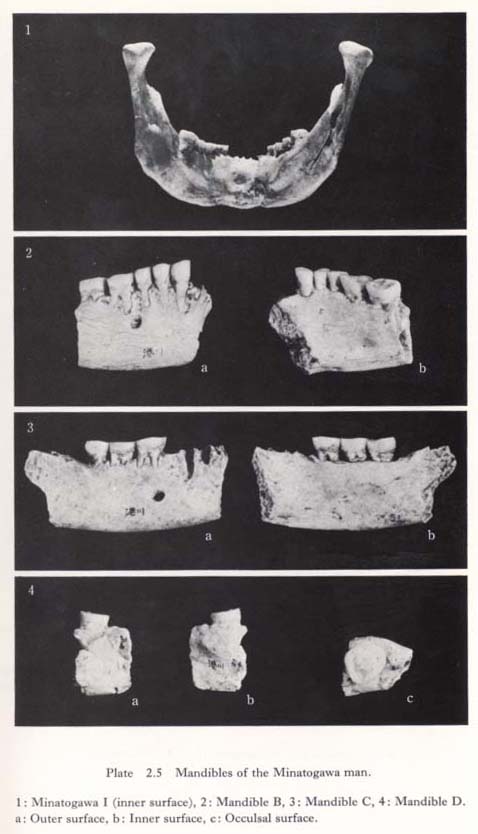
Mandible B represents a 53-mm-long fragment of the right half of the body without a ramus. The height and thickness of the mandible are quite the same as those of the Minatogawa I. The teeth are moderately worn and no caries can be seen. Therefore, the mandible seems to belong to an adult male individual.
The mental foramen, which is located below Pm2-M1, is large in size (5 mm × 5 mm). In the medial aspect, the alveolar prominence rises markedly, but no mandibular tori can be seen.
Mandible C (Pl. 2. 5, 3)
Mandible C was excavated from the C4 area and represents a 77-mm-long fragment of the right half of the mandible without most of the ramus. The mandible is smaller in height and thickness than that of Minatogawa I and mandible B, but nearly the same size as that of the isolated female mandible A.
The three molar teeth are in a good state of preservation. The chewing surface of M3 is slightly worn. Thus, the mandible is considered to be that of a young female individual.
The mental foramen is of large size (5 mm × 5 mm) and directed almost posteriorly. The fovea m. masseterica is remarkably well developed. No mandibular tori are seen on the medial surface of the mandible.
Mandible D (Pl. 2. 5, 4)
This is represented by a small fragment (19 mm long) of the most posterior part of the body and contains M3 of the left side. The height and thickness are about the same as those of the female mandible C. The chewing surface of M3 is only slightly worn. Therefore, the mandible is considered to belong to a young female individual.
In the lateral aspect, the sulcus extramolaris seems to be wider and deeper than that in modern man.
DISCUSSION
It is important to consider, on the basis of cranial features, the region in Asia from which the Minatogawa Pleistocene man of Okinawa originated.
The skeletal materials of prehistoric Homo sapiens in Asia are not really sufficient in number and quality. These materials have been available in their most complete form in China and Japan. Both of these regions are very important in view of the geographical situation of Okinawa.
It is well known that on the mainland of China, which is to the north of Okinawa, a number of prehistoric skeletons of Homo sapiens have been found, beginning with those of the Palaeolithic Upper Cave man, the Liukiang man and the Tseyang man (Woo, 1980). From a later age, neolithic skeletons have been found in Bampo (Yen et al., 1960) Dawenkou (Yen, 1972), Houhuahsien (Yen, 1962) and Hsihsiahou (Yen, 1973) from North China, in addition, those from Zhenpiyan cave site of South China (Zhang et al., 1977). On the mainland of Japan, situated to the east of Okinawa, the skeletal remains of the Mikkabi man (Suzuki et al., 1962) and Hamakita man (Suzuki et al., 1966) have been found, although these skeletal materials are inadequate as representative of Pleistocene man in Japan. Nevertheless, there are a fair number of findings comparable to the Minatogawa man from the succeeding Neolithic Jomon and Aeneolithic Yayoi ages.
Materials for prehistoric man from Southeast Asia are poor in number and quality. Among them, the Tabon Cave man from Palawan Island of the Philippines (Fox, 1970), the Niah Cave man from Borneo (Broth-well, 1960) and a right parietal bone of the Chocheng man from Taiwan (Shikama, et al., 1976) are well known, but they are not sufficient for detailed research.
Mainland of China
(1) Within the category of the late Palaeolithic man which inhabited China, the Upper Cave man (Weidenreich, 1938) is by far the most important for comparison with the material for the Minatogawa man. As can be seen from Tables 2.2 and 2.3 as well as Figs. 2.1 and 2.2, the endocranial capacity of the Upper Cave man is much greater than that of the Minatogawa man in either sex and is approximately equal to the average value of that of the Jomon man, which is used as a base line in the deviation graph. Furthermore, the cranial form of the Upper Cave man is dolichocranic in both sexes; this form occurs neither in the case of the Minatogawa man nor among Jomon men. This dolichocrany is based on the fact that the cranial length is exceptionally long, compared to the cranial breadth. The forehead of the Upper Cave man is wider than that of the average Jomon man. On comparison with that of the Minatogawa man, this difference is especially remarkable in absolute dimension and also in comparison with facial breadth; the forehead of the Minatogawa man is significantly narrow both in absolute dimension and in relation to the breadth of the face. In regard to facial form, the Minatogawa man and Jomon age man are hypereuryen-i.e., they possess an extremely low face. In contrast to this, the face of the Upper Cave man is remarkably high and is of the mesen type. This classification is based on the fact that the upper facial height of the latter is definitely higher than that of the former.
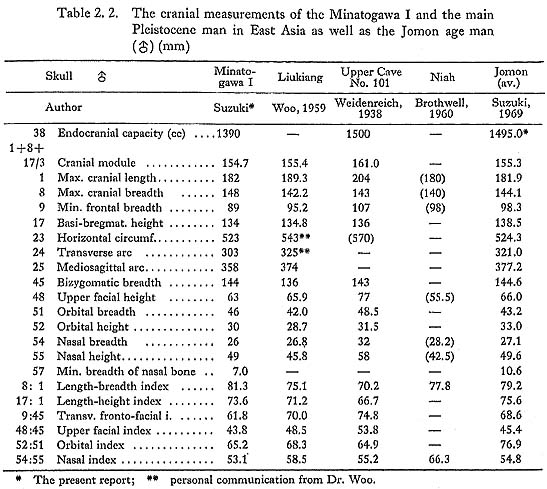
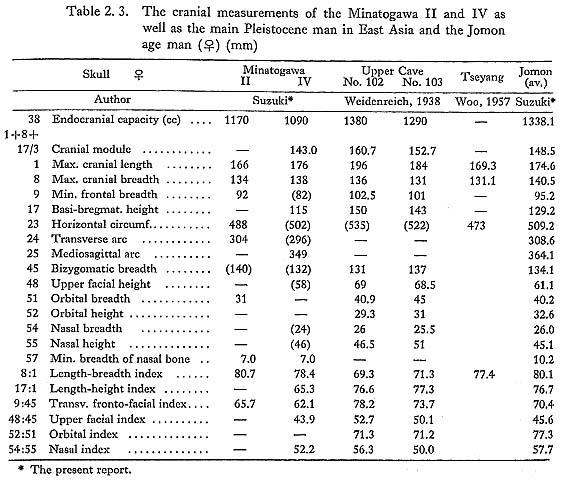


In accordance with the narrowness of the face, the nasal height of the Upper Cave man is remarkable high, but at the same time the nasal breadth is wide; consequently, the nasal form indicates the chamaerrhine, as in the case of the Minatogawa and Jomon man. The orbital width of the Upper Cave man is remarkably wider than that of the Minatogawa man, but the orbital height is lower than that of the latter. Consequently, the orbital form reveals an exceptionally remarkable chamaeconch. The Upper Cave man shows a narrow and pinched nose similar to that of the Minatogawa man, but this is never seen in the Neolithic Jomon man.
In addition to the differences mentioned above between the Upper Cave man and Minatogawa man, in contrast to the remarkably low stature of the latter (male, 155 cm; female, 144 cm), the high stature of the former (male skull No. 101, 174 cm; female skull No. 102, 159 cm) seems to suggest that these two have only a slight degree of racial affinity.
(2) The endocranial capacity and stature of the Liukiang man from South China (Woo, 1959) are not known. 6ut judging from the cranial module and horizontal circumference, these two features are much smaller in the case of the Upper Cave man and about the same in the case of the Minatogawa man and Jomon man (Table 2. 2; Fig. 2. 1). If it is permissible to make an assumption on the basis of these facts, the stature of the Liukiang man is low enough so that the approximate endocranial capacity does not vary very much from that of the latter two.
The skull of the Liukiang man is longer and narrower than that of the Minatogawa man. Consequently, the cranial form is intermediate between that of the Minatogawa and Upper Cave man. The width of the forehead is also intermediate between that of the Minatogawa and Upper Cave man, or rather close to that of the Jomon man. In regard to facial form, that of the Liukiang man is again midway between the hypereuryen of the Minatogawa man and the mesen of the Upper Cave man, or about the same as the Jomon man. The low orbit and wide nose of the Liukiang man, which are common characteristics in both the Minatogawa and Upper Cave man, are considered to be primitive features on their facial cranium.
(3) The Tseyang man is represented by an incomplete female calva from Central China and is considered to have originated in the late palaeolithic age (Pel and Woo, 1957).
On the basis of a few metrical data, the skull of the Tseyang man is very small in cranial size and almost the same as that of the Minatogawa II (Table 2. 3). It is pointed out that the cranial length of the Tseyang man is definitely shorter in comparison with the Upper Cave female skulls of Nos. 102 and 103. Consequently, the cranial form of the Tseyang man is mesocranic, in contrast to the dolichocranic form of the Upper Cave man.
(4) When making a comparison of the cranial features of the Neolithic people of China with those of the Jomon age man, the high cranial vault, narrow forehead and small circumference of the former can be pointed out, as shown in Tables 2. 4 and 2. 5 as well as Fig. 2. 3. However, the most characteristic features lie in the face. Although the face of Jomon man is remarkably euryen, most of the Neolithic people of China possessed a narrow face; among these can be observed even lepten or similar types, such as the Hauhsien (Yen, 1962) and the Kansu female (Black, 1928).
This is because the Neolithic people of China show a narrower facial breadth and higher facial height, compared to Jomon man (Fig. 2. 4, 1 and 2). In accordance with the narrow face of the Neolithic Chinese, the nasal form, compared to that of Jomon man, even has mesorrhine type, which is fairly close to leptorrhine, as in the case of the Kansu. In addition, the stature of the Neolithic man in China is high. That of the Jomon male is below 160 cm, but the Neolithic Hsihsiahou man's stature is as much as 171,3 cm (Yen, 1973); that of the Bampo is 169.45 cm (Yen et al., 1960a); of the Baoji, 169.45 cm (Yen et al., 1960b) and that of the Hauhsien, 168.4 cm (Yen, 1962). On the other hand, the Neolithic South Chinese seems to be different from the Neolithic North Chinese in skeletal features.
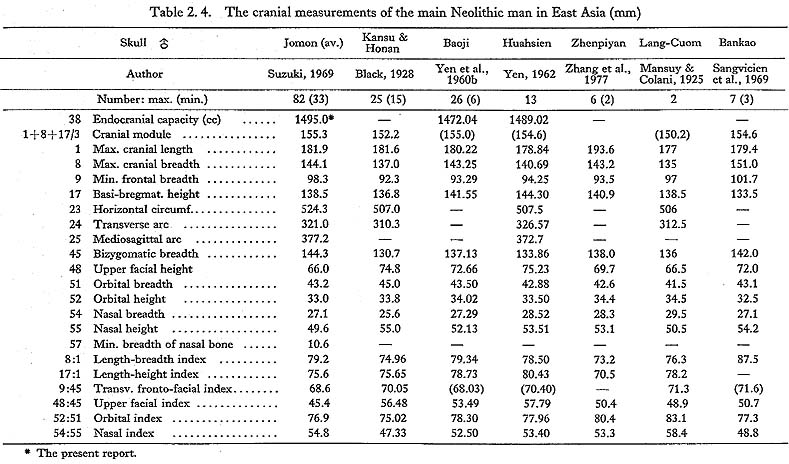
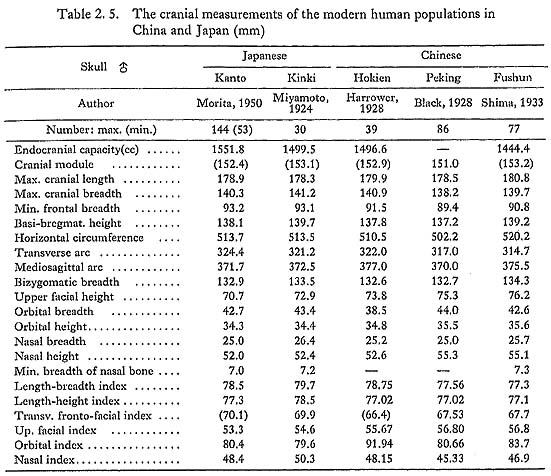


Judging from the Zhenpiyan man of Guangxi province, which is the only skeletons of early neolithic age in south China and considered to be close to the southern Asiatic Mongoloid (Zhang et al., 1977), the Neolithic South Chinese seems to have a longer head and broader and lower face than the North Chinese. The stature of the Zhenpiyan man is not known; but, on the basis of the writer's brief observation of the skeletons at the museum, the lengths of the extremity bones are estimated to be medium or even short. Thus, it will be possible to assume that the stature of the Neolithic South Chinese is much lower than that of the Neolithic North Chinese. In consideration of these facts, it may be considered that the Neolithic man in North China has a stronger affinity toward the Upper Cave man than do Jomon man, Minatogawa man or Liukiang man.
In contrast, the Zhenpiyan man of South China is supposed to be much closer in genetical relationship to the Liukiang man and the Neolithic Indochinese as well as to the Minatogawa man and the Jomon age man than to the Upper Cave man and the Neolithic North Chinese.
Southeast Asia
Among the late Pleistocene men of Southeast Asia, the Tabon Cave man of the Philippines is represented by only an isolated frontal bone. The Niah Cave man of Borneo is represented by an incomplete calvarium in young male individual; the cranial size was smaller than that of the Upper Cave man and about the same size as that of the Minatogawa and Liukiang man. The skull of the Niah Cave man indicates a wide fore head, low upper face and wide nose; its affinity to the Minatogawa man probably cannot be ruled out (Table 2. 2).
Neolithic skeletons of the Bankao man from Thailand (Sangvicien, 1966; Sangvicien et al., 1969) are characterized by a hyperbrachycranic, wide forehead, narrow face (mesen) and mesorrhine; in these respects, these skeletons from Bankao are particularly at variance with those of Minatogawa and Jomon man (Table 2. 4). However, on considering that the stature of the early Neolithic Bankao man was 170.0 cm, that of the late neolithic man 168.5 cm and that of the Iron age man 165 cm, it should be reasonable to hold that they had some affinity toward the Neolithic man of China, In contrast to this, the cranial sizes of Neolithic skeletons of Lang-Cuom (Mansuy and Colani, 1925) and Phobinhgia (Verneau, 1909) from northern Indochina do not exceed that of the Jomon man. The skulls were found to be mesocranic, euryen, mesoconch and hyperchamaerrhine (Table 2. 4). The statures of the Lang-Cuom and Phobinhgia man are not known but, assuming, on the basis of cranial dimensions, that they did not exceed that of the Jomon man, it must be considered that they had greater affinity toward the Liukiang and Minatogawa man and also toward the Neolithic Jomon age man of mainland of Japan and native Aeneolithic Yayoi age man of Kyushu than toward such prehistoric people as the Upper Cave man and Neolithic man of North China.
Mainland of Japan (Tables 2. 4, 2. 6)
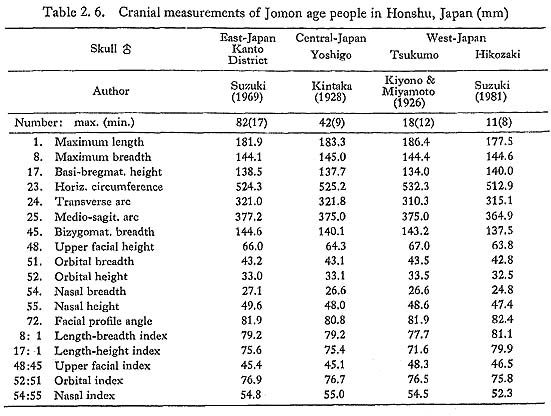
Neolithic Jomon age population
The Neolithic Jomon age man greatly differed from the neolithic men from North China. The stature of the former is estimated as 159.1 cm (Sano, 1956; Hiramoto, 1972), whereas that of the latter is around 170 cm as stated above. The cranial form of the former is of the mesocranic type in cranial index, and a dolichocranic example, as seen in the Upper Cave man, has not so far been found yet. The shape of the face in Jomon age people is extremely broad according to the upper facial index, which is significantly smaller than that of the Neolithic people from China. This is due to the greater bizygomatic breadth of the Jomon age people, although their facial height is significantly lower than that of the prehistoric Chinese (Fig, 2. 4). The orbital form of the Jomon man is no different from that of the prehistoric Chinese, but the former seems to have had a broader nose than the latter.
In this respect, the Jomon age people are, in general, rather more similar to the Minatogawa man in cranial features, such as the form of the cranial vault, face, orbita and nose, than are the Upper Cave man and the Neolithic population of north China.
Aeneolithic Yayoi age population (Table 2. 7)
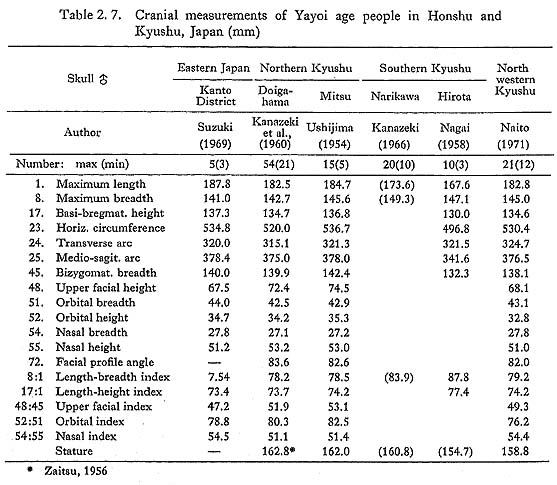
The neolithic Jomon age was followed in about the 3rd century B.C. by the Aeneolithic Yayoi age (3rd century B.C.-3rd century A.D.).
Although open sites from the Yayoi period are widely distributed throughout Japan, discoveries of human skeletons have so far been concentrated in the Kanto district in the east and the Kyushu district in the west.
Human skeletons from the Yayoi age in eastern Japan are transitional in physical characteristics between the prehistoric Jomon age populations and those of the protohistoric Kofun age (Suzuki, 1969).
On the other hand, the Yayoi age skeletons discovered at sites in the Kyushu district reveal various local differences in physical features. In this respect, they are divided broadly into two groups, a northern Kyushu group and those from the other regions in Kyushu, mainly from the southern and northwestern regions. So far as stature and cranial form are concerned, the northern Kyushu group (Mitsu and Doigahama sites) is quite different from the southern group (e.g. Hirota and Narikawa sites) in high stature, mesocranic and narrow face; they remind us of the Neolithic skeletons from North China (Table 2.4). In contrast to this, the northwestern Kyushu group (Goto Retto sites) shows similarities in cranial form to the northern group, but in facial form and stature it differs from the northern group and rather resembles the southern group and the Jomon people of western Japan such as Tsukumo man (Table 2. 6). Concerning this, Kanazeki (1966) gives the following explanation.
The differences in physical characteristics between the northern and southern group in Kyushu may already have begun .in the Jomon age, but the major origin of these differences could well be found in the possibility, that, at the end of the Jomon age, a Neolithic group from northern Korea, such as from the Ungkeuipho (Imamura, 1932) or the Hogi site (Suzuki, 1944), came over to the northern part of Kyushu and mixed with the native people there, but that this Korean influence did not reach the southern part of the Kyushu district.
On the other hand, according to Naito (1971), the northwestern Yayoi group discovered in the Goto Retto, just off the northwestern coast of Kyushu and within the course of immigration of the Neolithic Koreans assumed by Kanzeki, show no significant differences in cranial form. from those of the Mitsu and Doigahama sites or from the Jomon people of the Tsukumo site in Okayama prefecture. But judging also from stature and facial measurements, these Yayoi people of northwestern Kyushu were different from those of northern Kyushu in that they had a short stature and low faces; they rather resemble the Tsukumo man, a representative of the Neolithic Jomon age people in western Japan. In other words, they were not immigrants from the continent or Korea, but may have belonged to a group of people native to Kyushu since the Jomon age (Table 2. 6).
Morphological comparison of the Minatogawa man with populations of the surrounding area
In order to compare morphologically the Minatogawa man with other prehistoric and historic men from Asia, Penrose's shape distances were calculated.
First, a comparison was attempted of skeletons ranging from the prehistoric Jomon age to modern times.
(1) Age changes in Japanese skull characteristics since the Jomon age (Fig. 2. 5) On the basis of the morphological distances, Fig. 2, 5 was drawn using Hayashi's quantification theory model IV (Hayashi, 1954).
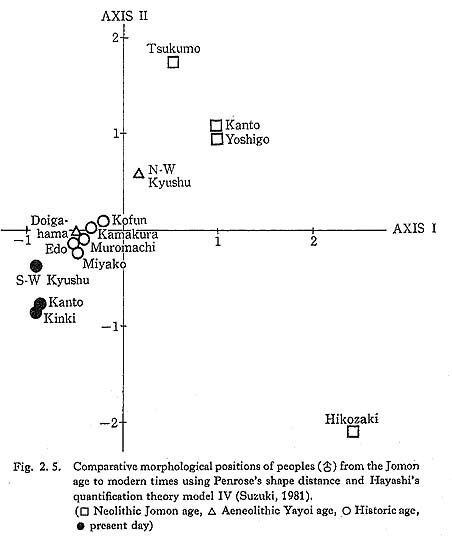
A single glance at the figure is enough to see that the bones of Honshu Japanese are located on a straight line, almost in the order of antiquity. The line starts with Jomon people in the upper right and descends leftward with the passing of time to the lower left, ending -with the present-day Japanese. However, upon examination, some inconsistencies in the order of time and geographical peculiarities can be found in this arrangement.
Among Jomon people there is great morphological variety. The Hikozaki man, in particular, is far removed morphologically from typical Jomon people of Honshu such as the Yoshigo man and the Tsukumo man, and gives the impression that he is actually of a different race.
If we limit our observation to the Kanto District in eastern Japan, we find that each period appears on the same line in chronological order: the Jomon age, the Kofun age (5th-9th century), the early medieval age (Kamakura era, 13th-14th century), the late medieval age (Muromachi era, 15th-16th century), the early modern age (Edo era, 17th-19th century), and the present. This result corresponds to the age changes of the Japanese skull reported by the present writer (Suzuki, 1956, 1969). The two large gaps, between the Joroon and Kofun people and between early modern Japanese and present-day Japanese, correspond to the acceleration of physical changes during the Aeneolithic Yayoi age and during the Meiji period (1868-1912).
In western Japan, the same tendency of age gradation seen in eastern Japan can be noted. However, there is a great shape distance between the Yayoi age people of northwestern Kyushu and those of Doigahama. The fact that the western Japan Yayoi age people's position in Fig. 2. 5 coincides with the extrapolated position of the Kanto Yayoi people, whereas the Doigahama man's position is closer to that of people of later ages, raises the possibility that the latter migrated from outside of Japan, possibly from North China or from the Korean peninsula, much later than the former.
It should be noted that the Jomon age population and, with the exception of the Mitsu-Doigahama man, the Yayoi age population in Kyushu and Honshu were, along with some prehistoric populations of Southeast Asia such as the Lang-Cuom and Phobinhgia man in Indochina, of low'stature and broad face (Table 2. 4; Fig. 2. 4). Even if these people are not related in the sense of direct consanguinity, these features probably indicate some related kinship between them.
(2) Comparison between the Minatogawa man and other Pleistocene men in eastern Asia (Fig. 2. 6).
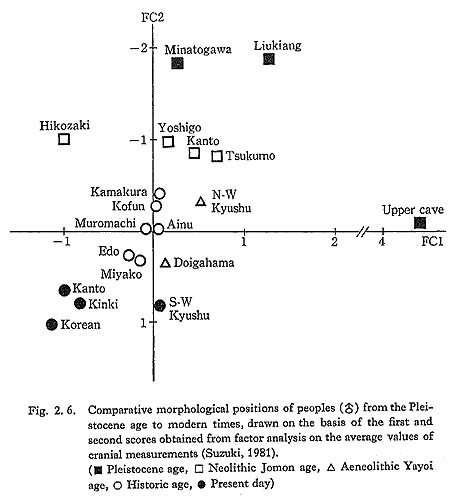
According to the results obtained from factor analysis of the average values of cranial measurements, including those from the Pleistocene age down to the present day, the same age changes in the skeletal characteristics of the Japanese population as those mentioned above are recognized. Furthermore, it is worth mentioning that the Minatogawa man is located much nearer morphologically to the Liukiang man of South China as well as the Jomon populations of the mainland of Japan than to the Upper Cave man of North China. This will suggest that the Minatogawa man has a closer genetic relationship to the former two than to the latter. Thus, the Minatogawa man may possibly be regarded as a cousin to Liuldang man and, at the same time, the remote ancestor of Jomon age man.
The aurale exostosis frequently noted in the Minatogawa man is considered to be a hereditary characteristic in man (Hrdlicka, 1935); it is known to occur frequently in the Jomon populations of Japan (Hasebe, 1925; Suzuki, 1975) and is also frequently seen in Sinanthropus (Weidenreich, 1943). These features, along with the facial flatness noted in the Jomon and Minatogawa man, seem to suggest that both the Jomon and Minatogawa man are Mongoloid and that their common ancestors can be traced as far back as Sinanthropus.
On the other hand, though the Minatogawa man shows a narrow and pinched nasal bone in common with the Upper Cave man, this kind of nasal bone is never seen in the Jomon man. The same is also true in the case of the saber-hilt-shaped zygomatic arc and the transverse occipital torus. Similarly, the mandibular torus frequently seen in Sinanthropus is never found in the Minatogawa man and the Bankao man but is frequently seen in the Jomon man-e.g., 71.1% in the Tsukumo shellmound population (Kihono and Miyamoto 1926) and 59.3% in the Yoshigo shellmound population (Kintaka, 1928) (Table 2. 8).
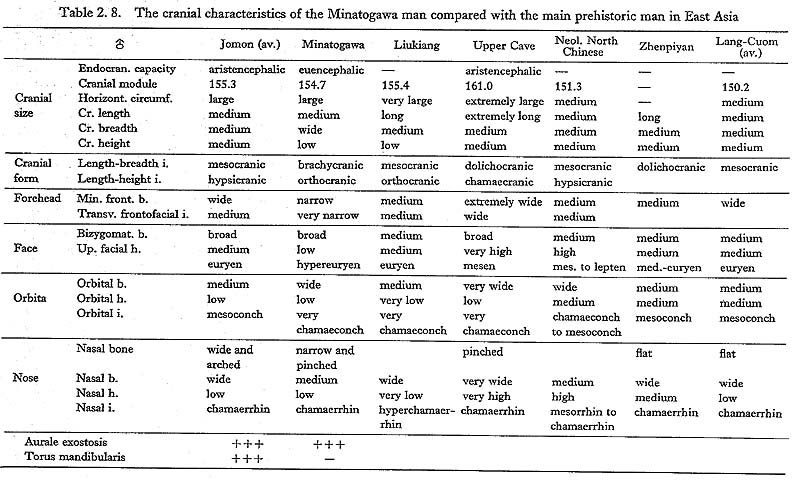
On the basis of these features of the Minatogawa man, it is possible to suppose that the Minatogawa man descended from a generalized Pleistocene proto-Mongoloid of the Asian continent, which makes him a common ancestor of the Liuldang man and the Upper Cave man. Most likely, insofar as the available skeletal materials are concerned, about 18,000 years or more ago, an offspring of the South China branch of this proto-Mongoloid stock, who had deep racial ties with the Palaeolithic Liukiang man and the Neolithic Lang-Cuom and Phobinghia man, migrated eastward to Okinawa on the one hand and to the western part of the mainland of Japan on the other hand over the land bridge that existed at that time between the Asian continent, Okinawa and the mainland of Japan. The Minatogawa man from Okinawa and the Pleistocene man from the mainland of Japan, i.e. the Ushikawa man (Suzuki and Takai, 1959), the Mikkabi man (Suzuki et al., 1962), and the Hamakita man (Suzuki et al., 1966) are probably the immigrants themselves or their descendants.
As a result of a long period of isolation and the gene flow which took place within this period, a number of changes in the physical characteristics of these immigrants came about in Okinawa and the mainland of Japan, which resulted in the observed differences between the Pleistocene Okinawans and the Neolithic Japanese. Modern Okinawans differ even today from the mainland Japanese of today in their low stature, low face, existence of aurale exostosia (Suzuki, 1975; Pl. 2, 8, c), etc, Considering that present-day Okinawans are, without doubt, the direct descendants of the Minatogawa man, these features are due probably to the inheritance of traits from the Minatogawa man of the Upper Pleistocene age.

In the same way, the resemblance of the physical characteristics of the Southeast Asian natives, such as those of Taiwan, the Philippines and Borneo, to those of the Okinawans is also probably the result of common Pleistocene ancestors (Figs. 2. 4, 8).
Artificial tooth extraction of the Minatogawa man
Special attention should be directed to the symmetric extraction of both median incisors on mandible A (Pl. 2. 4). The tooth sockets are completely obliterated, and their alveolar margin indicates a concave sharp ridge 10 mm long. Except for 4 postmortem fallen teeth, whose sockets are seen fresh, all other teeth are in healthy condition with only slight attrition. It is quite possible that these teeth were artificially extracted by being knocked out. If so, in the light of the Pleistocene origin of this bone (Matsu'ura, the present report), this example may be considered the earliest so far known in Japan.
Since both lateral incisors show no indication of medial rotation, both median incisors must have been extracted not very long before death.
As is well known, the custom of artificial knocking-out of teeth was practiced all over the world. In Japan this custom was widely carried out from the Neolithic Jomon age to the Aeneolithic Yayoi age, from the northern to the southern districts. The oldest examples of this kind of extraction so far reported are those of the early and middle Jomon periods and are scattered in the western part of Japan-from shell mounds of Okayama, Hiroshima and Kumamoto prefectures. These earliest case show the knocking-out of lower median incisors on both sides just as in the present specimen (Yamanouchi, 1937; Watanabe, 1966). This pattern of tooth extraction is restricted to the period stated above. In the succeeding period, this extraction pattern disappeared completely, and instead there appeared many complicated patterns of tooth extraction (Suzuki, 1937; Watanabe, 1966; Harunari, 1973).
In Okinawa, no such cases from the prehistoric age have been reported so far; there have only been cases from the Aeneolithic Yayoi age.
In China, the artificial knocking-out of upper lateral incisors is reported for the neolithic age of about 5,000 years before the present, such as that from Dawenkou of Shantung province (Yen, 1972), from Hsihsiahou of Shantung province (Yen, 1973), etc. The same pattern of extraction as in China is observed in the Neolithic population of Bankao in Thailand (Sangvicien et al., 1969).
Information on the age of the first appearance of this artificial knocking-out of teeth is scant even now. Except for the questionable obliteration of both median incisors of the Palaeolithic Gibraltar man, the earliest examples of the artificial knocking-out of the teeth are those in Epipalaeolithic populations from North Africa, such as the Afalou bou-Rhummel of Algeria (Vallois, 1952) or the Taforalt of Morocco (Ferembach, 1962), both of which are considered to be of about 12,000-10,000 years before the present. Their upper median incisors had been extracted in childhood and also, in some cases, the upper lateral incisors. On the other hand, the Mesolithic populations from north Africa such as the Mechta et Arbi (about 8,400 years before present) had extracted only both median incisors of the lower jaw, just as in the present specimen, and in some cases the incisors were also removed from the upper jaw (Verger-Pratoucy, 1968).
In regard to the artificial knocking-out of the teeth, Asia is one of the main areas in the world, along with Africa, Polynesia, Australia and South America where this has occurred. In consideration of the fact that, in the Epipalaeolithic age, the artificial knock ing-out of the teeth was actually observed in North Africa, it is conceivable that this custom occurred independently in the Upper Palaeolithic age on the island of Okinawa. Then this case would represent the earliest example of the artificial knocking-out of the teeth in the world.
Minatogawa man as victim
The human skeletons of at least 5 or at most 9 individuals and more than 200 boar and deer bones were excavated from a relatively narrow area of the fissure deposits of the site, about 6 meters broad, 5 meters high and 1 meter deep.
Except for the Minatogawa I, which was found in an anatomically normal state in a position standing on the head, the others were scattered in fragments of bones over wide areas (Fig. 1.2).
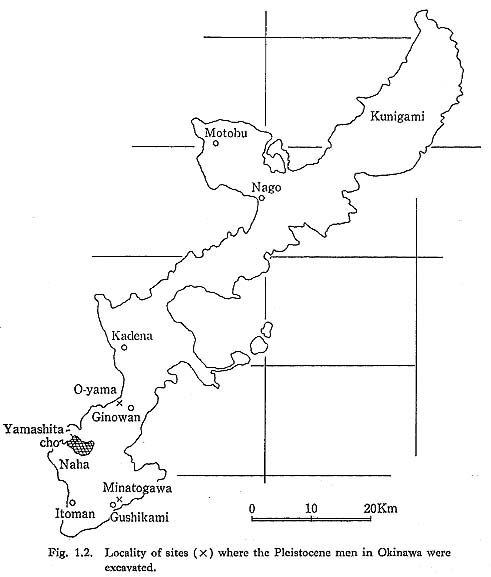
The question arises as to why so many human and animal bones were found so close together at the site. The most plausible explanation for this is that these people died as a result of some natural accident such as a flood or earthquake or were thrown into the fissure by other humans.
It may be recalled that the Minatogawa IV had a small perforation on the forehead, perhaps as a result of some violent force from the outside, and a similar perforation on the isolated occipital bone fragment A.
The writer prefers the explanation that the Minatogawa man was attacked by his own people or by some foreign enemy and that the corpses were abandoned along with animal bones in a fissure used as a Kitchen-midden. It is reasonable to consider that these vic tims were cannibalized and their bones broken into fragments of bones by their oppo nents, as has been observed in Europe (Gieseler, 1952) and Japan (Suzuki, 1938, 1966).
SUMMARY
The human skeletons found during three seasons of excavating the Minatogawa limestone fissure deposits on the Island of Okinawa consist of at least 5 or at most 9 individuals, of which the two are individuals of the male sex and the others are females. Except for the Minatogawa I, the bones are found as scattered fragments along with, now-extinct animal bone fragments over wide areas at the site. The bones were deter mined to be ca. 18,250 years B.P. by the C-14 dating method. This means that the skeletons are those of late Pleistocene man. The cranial features of these individuals are nearly the same, except for certain individual and sexual differences.
The remarkable asymmetry of the Minatogawa II skull, viewed from above, is con sidered to be not of natural origin but to have some pathological cause such as con genital or postnatal torticollis.
The characteristic features of the Minatogawa man can be summarized as follows. Their stature is estimated to be 155 cm in the male and 144 cm in the female on average, The cranial capacities are quite small and coincide with those of the minimum range for both modern and prehistoric populations in Japan.
The cranial features in norma frontalis: low and broad face with narrow forehead, well-developed supraorbital ridge, low orbit, wide nose with remarkably receded nasal root, elevated and pinched nose, medially rotated malar bone.
Norma lateralis: developed supramastoid crest and zygomatic crest, deep and spacious temporal fossa, saber-hilt-formed zygomatic arc, massive mastoid process with wide and shallow digastric fossa, existence of ear-exostosis.
Norma occipitalis: developmentof the transverse occipital tori with suprainial fossa.
Mandible: no praeangular notch, positive submental notch, development of fossula supraspinata, development of superior and inferior transverse tori, deep fossa prae coronoidea, no mandibular tori. Most of these features are regarded as primitive and are frequently observed in fossil man such as Sinanthropus, but the other features are considered racial characteristics.
On the basis of these cranial features in the Minatogawa man, it is possible to spec ulate about the region from which they originated-the mainland of China, Southeast Asia or Japan. It is considered that the Jomon age man in Japan is much closer geneti cally to the Minatogawa man, the Liuldang man and the Neolithic man of South China and North Indochina than to the Upper Cave man and the Neolithic man of North China. Consequently, insofar as available skeletal material shows, about 18,000 years or more ago, some generalized proto-Mongoloids from South China as well as from North Indochina, having deep racial ties with the Liukiang man, the Zhenpiyan man and the Lang-Cuom man, migrated to Okinawa and the mainland of Japan over a landbridge existing at that time. The Minatogawa man and the Mikkabi-Hamakita man from the mainland of Japan are probably the immigrants themselves or the descendants of these immigrants.
The symmetric extraction of both median incisors on mandible A is regarded as artificial knocking-out of the teeth. If so, this example derived from the late Palaeo lithic age may be considered the earliest so far known in Japan or even in the entire world.
The burial state of the Minatogawa man indicates that they were attacked by mem bers of their own race or by some foreign enemy and that the corpses were abandoned along with animal bones in a fissure used as a Kitchen-midden.
REFERENCES
- Ando, T. (1938)
- Anthropologische Untersuchung über die Schädel der Hsinking-Chinesen. Kaibogaku Zassi, 11: 1-60.
- Black, D. (1928)
- A study of Kansu and Honan aeneolithic skulls and specimens from later Kansu prehistoric sites in comparison with North China and other recent crania. Palaeont. Sinica, 6: 1-83.
- Bonin, G. von (1931)
- Beitrag zur Kraniologie von Ost-Asien. Biometrika, 23: 52-95.
- Brothwell, D. (1960)
- Upper Pleistocene human skull from Niah Caves, Sarawak. The Sara wak Museum J., 9: 323-349.
- Chang, C. (1949)
- Anthropologische Untersuchungen über die Schädel von Atayal in For mosa. Bull. Anat. Dept., National Taiwan Univ., Formosa, 6: 59-154.
- Ferembach, D. (1962)
- La nécropolc épipaléolithique de Taforalt (Maroc oriental), étude de squelettes humains. Centre National de la Recherche Scientifique et de la Mission univer- sitaire et culturelle française au Maroc.
- Fox, R. (1970)
- The Tabon Caves-archaeological explorations and excavations on Palawan Island, Philippines. Monograph of the National Museum, No. 1.
- Genet-Varcin, E. (1951)
- Les Négritos de l'Ile de Lucon (Philippines). Masson et C10, edi teurs. Paris.
- Gieseler, W. (1952)
- Schädelverlrtzungen, Kannibalismus und Bestattungen im europäischen Palaeolithikum. "Aus der Heimat", 60: 161-173.
 -Kramberger, K. (1906) -Kramberger, K. (1906)- Der diluviale Mensch von Krapina in Kroatien. Kreidel, Wiesbaden.
- Harada, T. (1954)
- Craniometrical studies on the south-western Japanese population. Jinruiga kuKenkyu, 1: 1-51.
- Harrower, G. (1928)
- A study of the crania of the Hylam Chinese. Biometrika, 9B: 245-278.
- Harunari, H. (1973)
- Significance of tooth-extraction. Koko-gaku Kenkyu, 20: 25-48.
- Hasebe, K. (1925)
- Ear exostoses are frequently seen in the neolithic sites around Ofunato Bay, Miyagi Prefecture. J. Anthrop. Soc. Nippon, 40: 321-326.
- Hayashi, C. (1954)
- Multidimensional quantification with the applications to analysis of social phenomena. Ann. Statist. Mathem., 5: 121-143.
- Hiramoto, Y. (1972)
- Secular changes of estimated stature of Japanese in Kanto district from the prehistoric age to the present day. J. Anthrop. Soc. Nippon, 80: 221-236.
- Hrdlicka, A. (1935)
- Ear exostosis. Smiths. Miscell. Coll., Vol. 93, Publication 3296: 1-98.
- Hsii, Hung-liang (1948)
- Anthropogische Untersuchungen über die Schädel der Riukiu Insulaner. Bull. Anat. Dept., National Taiwan Univ., Formosa, Fasc. 2: 227-330.
- Ikeda, J. (1974)
- Craniometry of Miyako Islanders, the Ryukyus. J. Anthrop. Soc. Nippon, 82: 150-160.
- Imamura, Y. (1932)
- The skulls and other skeletons of the stone age people found near Ung Keui-pho, Corea. J. Anthrop. Soc. Tokyo, 47: 447-469.
- Kanazeki, T., Tseng, J. and Chang, C. (1949)
- Kraniometrie des Paiwan-und des Bunun Schädel Formosa. Bull. Anat. Dept., National Taiwan Univ., Formosa, Fasc. 6: 205-216.
- Kanazeki, T. (1959)
- Japanese population in the Yayoi Age. (in: Transactions of the fifteenth general assembly of the Japan medical congress, Tokyo, in 1959: 77-78).
- Kanazeki, T. (1966)
- People of Yayoi Age. (in: Archaeology of Japan. 3, Wajima ed., Yayoi Age. Kawade Shobo-Shinsha, Tokyo).
- Kanazeki, T., Nagai, M. and Sano, H. (1960)
- Craniological studies of the Yayoi-Period ancients, excavated at Doigahama Site, Yamaguchi Prefecture. Jinruigaku Kenkyu (The Quarterly Journal of Anthropology), 7: appendix, 1-36.
- Keiter, F. (1935)
- Unterkiefer aus Australien und Neuguinea aus dem Nachlasse Rudolf Pöchs. Zeitschr. Morphol. Anthropol., 33: 190-226.
- Kikuchi, J. (1959)
- An anthropological study of the cranial bones of the Yoro Islands, Oshima gun, Kagoshima Prefecture, Japan. Jinruigaku Kenkyu, 6: 196-398.
- Kintaka, K. (1928)
- Anthropogische Untersuchungen über das Skelett der Yoshigo-Stein zeitmenschen. I. Der schädel. J. Anthr. Soc. Tokyo, 43: supplements, 497-736.
- Kiyono, K. and Miyamoto, H. (1926)
- Anthropological study on the human skeletons from the Tsukumo Shellmounds, Bitchu. II. Skulls. J. Anthr. Soc. Tokyo, 41: 95-140, 151-208.
- Klaatsch, H. (1909)
- Kraniomorphologie und Kraniotrigonometrie. Arch. Anthrop., 36: 101-123.
- Kobayashi, H., Matsui, Y. and Suzuki, H. (1971)
- TK-78. Yamashita-cho Cave 1. Radio carbon, 13: 100.
- Kobayashi, H., Hirose, T., Sugino, M. and Watanabe, N. (1974)
- TK-99. Minatogawa. Radio carbon, 16: 384.
- Mansuy, H. (1924)
- Stations prehistoriques dans les cavernes du massif calcaire de Bac-Son (Tonkin). Mem. Serv. Geolog. 1'Indochine, 11: 7-26.
- Mansuy, H. and Colani, M. (1925)
- Neolithique inferieur (Bacsonien) et neolithique superieur dans le Haut-Tonkin avec la description des cranes du gisement de Lang-Cuom. Mem. Serv. Geolog. 1'Indochine, 12: 6-45.
- Martin, R. (1928)
- Lehrbuch der Anthropologie. Bd. 2. G. Fischer, Jena.
- Matiegka, J. (1934)
- Homo P
 edmostensis. L'homme fossile de P edmostensis. L'homme fossile de P edmosti en Moravie (Tcheco slovaquie). I. Les cranes. Academic Tcheque des Sciences et des Arts. Prague. edmosti en Moravie (Tcheco slovaquie). I. Les cranes. Academic Tcheque des Sciences et des Arts. Prague.
- Matsumoto, S. (1956)
- Anthropological study on the skulls of the modern Japanese populations in middle Kyushu (Higo). J. Kumamoto Med. Soc., 30: 834-879.
- McCown, T. D. and Keith, A. (1939)
- The stone age of Mount Carmel. Vol. 2. Clarendon, Oxford.
- Miyamoto, H. (1924)
- Anthropological study on the modern Japanese skeletons. 1. The skull. J. Anthrop. Soc. Tokyo, 39: 307-451.
- Morita, S., (1950)
- Anthropological studies on the skull of the recent Japanese in Kanto Dis trict. Mem. Dept. Anatomy, Tokyo Jikeikai Medical College.
- Nagai, M. (1958)
- Cited from: Kanazeki, T., Yayoi Age people. (in: Wajima, S. ed., Yayoi Age; Archaeology in Japan, 3: 460-471).
- Naito, Y. (1971)
- On the human skeletons of Yayoi Period at the sites in North-western Kyu shu. J. Anthrop. Soc. Nippon, 79: 236-248.
- Nakano, T. (1958)
- An anthropological study on the skulls of Kikai-islanders of Amami Archi pelago, Japan. Jinruigaku Kenkyu, 5: 188-219.
- Oyama, H. (1956)
- Craniological studies on the Yoron Islanders, Oshima-gun, Kagoshima Prefecture, Japan. Jinruigaku Kenkyu (The Quarterly J. Anthrop.), 3: 396-434.
- Pei, W. C. and Woo, J. K, (1957)
- Tzeyang Palaeolithic man. Inst. Vertebrate Palaeont., Memoire, 1.
- Sangvicien, S. (1966)
- Neolithic skeletons from Bankao, Thailand, and the problem of Thai Origins. Current Anthrop., 7: 234-235.
- Sangvicien, S., Sirigaroon, P. and Jørgensen, J.B. (1969)
- Bankao-Neolithic cemeteries in the Kanchanaburi Province. II. The prehistoric Thai skeletons. Archaeological excavations in Thailand. Vol. 3.
- Sano, H. (1956)
- Chronological changes of the Japanese tibiae from the prehistoric age to the present-day. Master's thesis, Fac. Sci., Univ. Tokyo.
- Shikama, T., Ling, C. C., Shimoda, N. and Baba, H. (1976)
- Discovery of fossil Homo sapiens from Cho-chen in Taiwan. J. Anthrop. Soc. Nippon, 84: 131-138.
- Shima, G., (1933)
- Anthropological study of the Chinese skull obtained from the suburbs of Fushun, Manchuria. J. Anthrop. Soc. Tokyo, 48: 423-537.
- Shima, G. (1934)
- Further notes on the anthropological studies of the modern Korean. The skull. J. Anthrop. Soc. Tokyo, 49: 245-269.
- Su, T. L. (1949)
- Kraniometrie der Schädel von Igorrot, Philippine. Bull. Anat. Dept., Na tional Taiwan Univ., Formosa, Fasc., 5: 175-180.
- Sullivan, L. R. (1921)
- A few Andamanese skulls with comparative notes on Negrito cranio metry. Anthrop. Pap. Amer. Mus. Nat. Hist., 23: 177-201.
- Suzuki, H. (1937)
- Artificial deformations of the human dentition. Jinrui-gaku Senshi-gaku Koza (Lectures on Anthropology and Prehistory), 12: 1-51.
- Suzuki, H. (1938)
- Injuries by sharp-edged tools on the neolithic skeletons in Japan. J. An throp. Soc. Tokyo, 53: 315-347.
- Suzuki, H. (1954)
- Secular changes of the form of nasal root from the prehistoric age to modern times in Japan. Proc. Joint Meeting, Anthrop. Soc. Nippon and Jap. Soc. Ethn. 7th Session, 1952,83-87.
- Suzuki, H. (1956)
- Changes in the skull features of the Japanese people from ancient to modern times. Selected Papers, Fifth CISAE, Philadelphia, 1956. Men and Cultures, 717-724.
- Suzuki, H. (1960)
- Recent discoveries of Pleistocene Man in Japan. Actes du VI-e CISAE, Paris, 1:705-711.
- Suzuki, H. (1966)
- Cannibalism of the aeneolithic period in Japan. Proc. Joint Meeting, An throp. Soc. Nippon and Jap. Soc. Ethn., 20: 135-137.
- Suzuki, H. (1969)
- Microevolutional changes in the Japanese population from the prehistoric age to the present-day. J. Fac. Sci. Univ. Tokyo, Sec. V, 3: 279-308.
- Suzuki, H. (1970)
- The skull of the Amud man. In: Suzuki, H. and Takai, F. ed. The Amud man and his cave site. The University of Tokyo, 123-206.
- Suzuki, H. (1975)
- Discoveries of the fossil man from Okinawa Island. J. Anthrop. Soc. Nip pon, 83:113-124.
- Suzuki, H., (1981):
- Racial history of the Japanese (in: I. Schwidetzky ed.: Rassengeschichte der Menschheit, 8. Lieferung: 7-69).
- Suzuki, H. and Takai, F. (1959)
- Entdeckung eines Pliestozänen hominiden Humerus in Zentral-Japan. Anthrop. Anz., 23: 224-235.
- Suzuki, H., Hayashi, T., Tanabe, G. and Sakura, H. (1956)
- Cranial features of the medieval Japanese. (in: Medieval Japanese skeletons from the burial site at Zaimokuza, Kamakura City. Compiled by the Anthrop. Soc. of Nippon. Iwanami Shoten, Tokyo.)
- Suzuki, H., Takai, F., Endo, B., Chinzei, K. and Tanabe, G. (1962)
- Mikkabi man and the fossil-bearing deposits from Tadaki Limestone Quarry at Mikkabi, Central Japan. J. Anthrop. Soc. Nippon, 70:1-48.
- Suzuki, H., Takai, F., Endo, B., Hasegawa, Y., Chinzei, K. and Tanabe, G. (1966)
- Hamakita man and the site of Nekata Limestone Quarry at Hamakita. J. Anthrop. Soc. Nippon, 74: 101-176.
- Suzuki, M. (1944)
- Ueber die Skelette der Steinzeitmenschen aus Hogi in der Nähe von Kainei, Chosen. J. Anthrop. Soc. Nippon, 59: 228-247.
- Takamiya, H. (1965)
- Okinawa no Kyusekki (Palaeolithic culture of Okinawa Islands). Rekishi- Kyoiku, 13: 39-43.
- Takamiya, H. (1968)
- Archaeological findings of Naha City. Source materials for the History of Naha City, 1:247-255.
- Todd, T. W. and Lyon, D. W. (1924)
- Endocranial suture closure. Its progress and age relation ship. I. Adult males of white stock. Am. J. Phys. Anthrop., 7: 325-384.
- Todd, T. W. and Lyon, D. W. (1925)
- Cranial suture closure. Its progress and age relation ship. II. Ectocranial closure in adult males of white stock. Am. J. Phys. Anthrop., 8: 23-45.
- Tokunaga, S. (1936)
- Bone artifacts used by ancient man in the Riukiu Islands. Proc. Imp. Acad. Tokyo, 12: 352-354.
- Ueda, T., Suzuki, K., Nishiki, S., Ito, I. and Iwasaki, S. (1942)
- Contribution to the physical anthropology of the Korean from Keiki-Do. J. Anthrop. Soc. Nippon, 57: 398-404.
- Ushijima, Y. (1954)
- The human skeletal remains from the Mitsu site, Saga Pref., a site asso ciated with the "Yayoishiki" period of prehistoric Japan. Jinruigaku Kenkyu (The Quarterly J. Anthropology), 1: 273-303.
- Vallois, H. (1952)
- Diagrammes craniens sagittaux et mensulations individuelles des Hommes fossiles d'Afalou-bou-Rhummel, Travaux de Laboratoire d'Anthropologie prehistorique du Musée du Bardo. V.
- Verger-Pratoucy, J. (1968)
- Recherches sur les mutilations maxillo-dentaires prehistoriques. Thése pour le doctorat en médicine. Université de Bordeux.
- Verneau, R. (1909)
- Les cranes humains du gisement prehistorique de Pho-Binh-Gia (Tonkin). L'Anthropologie, 20: 545-559.
- Watanabe, M. (1966)
- A study on the teeth extraction in the Jomon age. Kodaigaku (Palaeo logia), 12: 173-201.
- Weidenreich, F. (1936)
- The mandibles of Sinanthropus pekinensis: a comparative study. Palaeont. Sin., Ser. D, Vol., Fasc. 3
- Weidenreich, F. (1938)
- On the earliest representatives of modern mankind recovered on the soil of East Asia. Peking Natural History Bulletin, 13: 205-224.
- Weidenreich, F. (1943)
- The skull of Sinanthropus pekinensis, a comparative study of a primi tive hominid skull. Palaeontologia sinica, new series D. No. 10.
- Woo, J. K. (1957)
- II. Fossil human skull from Tseyang district, Szechuan Province. In: Pei and Woo, 1957: Tseyang Palaeolithic man. Inst. Vertebr. Palaeont., Memore 1, 13-49.
- Woo, J. K. (1959)
- Human fossils found in Liukiang, Kwangsi, China. Vertebrata Palasiatica, 3:109-118.
- Woo, J. K. (1980):
- Palaeoanthropology in China (1949-1979). Vertebrata Palasiatica, 18: 1-8.
- Woo, T. L. and Morant, G. M. (1934)
- A biometric study of the "flatness" of the facial skeleton in man. Biometrika, 26: 196-250.
- Yamaguchi, B. (1973)
- Facial flatness measurements of the Ainu and Japanese crania. Bull. Nat. Sci. Mus., 16: 161-171.
- Yamaguchi, B. (1980)
- A study on the facial flatness of the Jomon crania. Bull. Nat. Sci. Mus., Series D, 6: 21-28.
- Yamanouchi, S. (1937)
- Nippon Senshijidai ni okeru Basshi fushu no Keito (The descent of the custom of artificial knocking-out of the teeth in. prehistoric Japan). Senshi Kokogaku, 1:53-60.
- Yang, H. (1970)
- Recent studies of the Anyang Skulls (1966-1969). Bull., Institute of History and Philology, Academia Sinica, Vol. 42, Part II (In Honor of Dr. Wang Shih-chieh on his 80th Birthday). Taipei, Taiwan.
- Yen, Y., Liu, C. and Gu, Y. (1960a)
- Bampo. Kaogu, 1969-9: 234-242.
- Yen, Y., Liu, C. and Gu, Y. (1960b)
- Report on the skeletal remains from the neolithic site at Baoji, Shensi. Vertebrata Palasiatica, 4: 103-111.
- Yen, Y. (1962)
- Neolithic human skeletons unearthed at Hua-Hsien, Shensi. Kaogu Xuebao (The Chinese Journal of Archaeology), 1962-2: 85-104.
- Yen, Y. (1972)
- Report on the neolithic human skeletons from the site of Dawenkou, Shan tung Province. Kaogu Xuebao (The Chinese Journal of Archaeology), 1972-1:91-122.
- Yen, Y. (1973)
- The neolithic human skeletal remains from Hsi-hsiahou. Kaogu Xuebao (The Chinese Journal of Archaeology), 1973-2: 91-126.
- Yokoh, Y. (1931)
- Beiträge zur physischen Anthropologie der Dajaken, Borneo. J. Anthrop. Soc. Tokyo, 46: 339-703.
- Zaitsu, H. (1956)
- On the limb bones of certain Yayoi-period ancients, excavated at Doigahama Site, Yamaguchi Prefecture. Jinruigaku Kenkyu, 3: 320-349.
- Zhang, Z. (1980)
- On the racial type of the skulls from the neolithic site at Yedian in Zouhsien Counter, Shantung Province. Vertebrata Palasiatica, 18: 65-75.
- Zhang, Y., Wang, L. and Dong, X. (1977)
- The human skulls from Zhenpiyan neolithic site at Guilin, Guanxi. Vertebrata palasiatica, 15: 4-13.
(Address: Emer. Prof. H. Suzuki, Dept. of Anthropology, Faculty of Science, The Univer sity of Tokyo, Hongo, Tokyo, Japan)
|
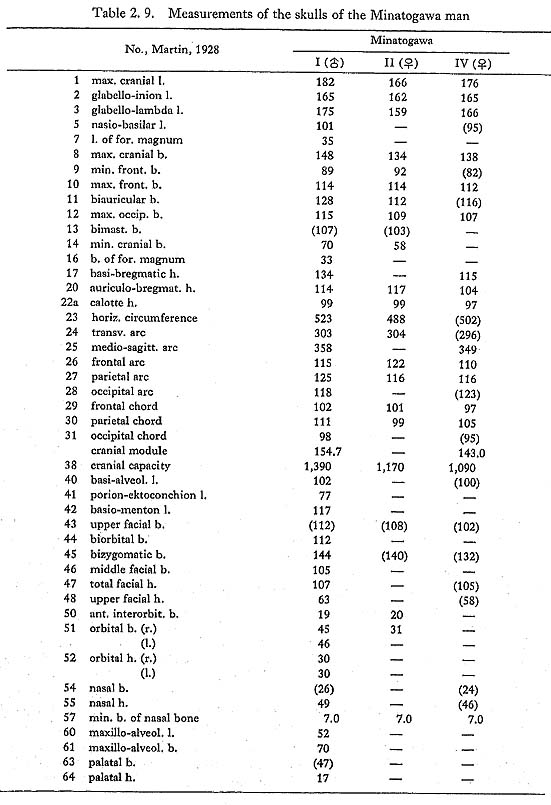
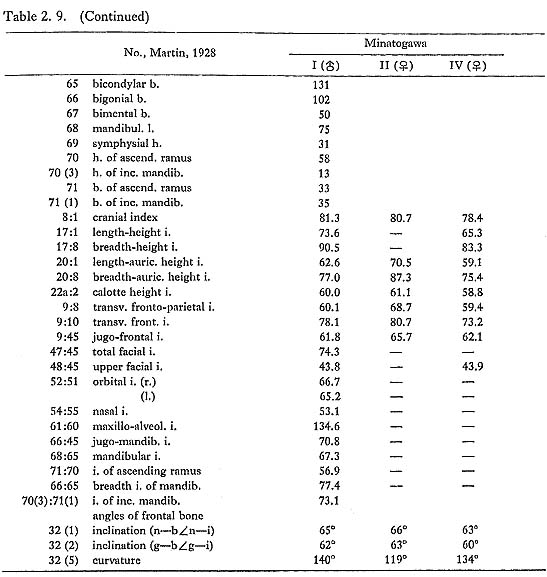
 -Kramberger, K. (1906)
-Kramberger, K. (1906) edmostensis. L'homme fossile de P
edmostensis. L'homme fossile de P edmosti en Moravie (Tcheco slovaquie). I. Les cranes. Academic Tcheque des Sciences et des Arts. Prague.
edmosti en Moravie (Tcheco slovaquie). I. Les cranes. Academic Tcheque des Sciences et des Arts. Prague.















